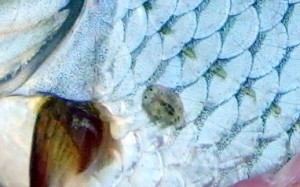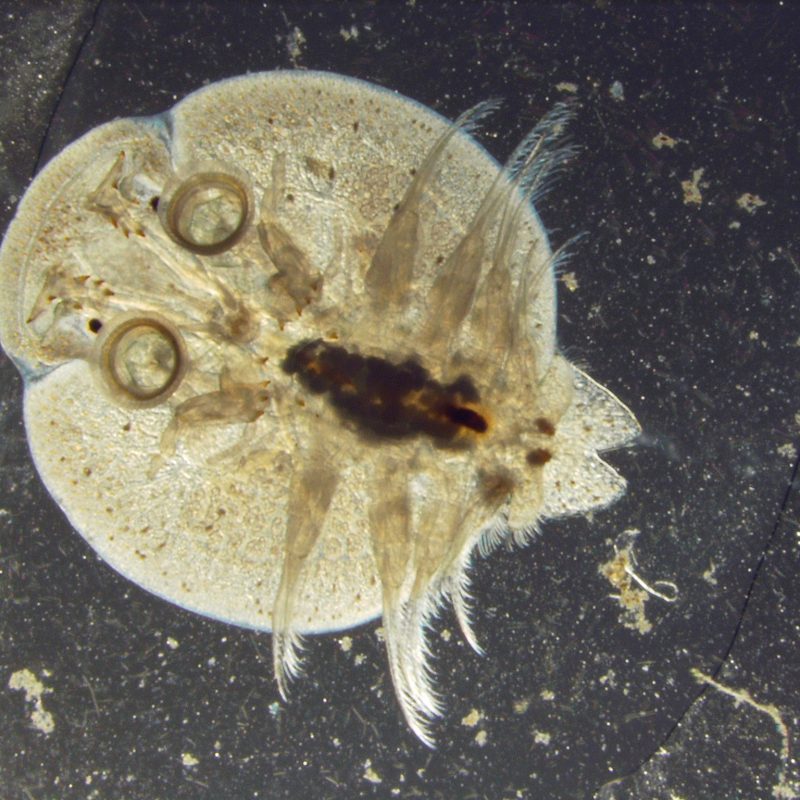In the truest sense of the word, fish lice (or Argulus foliaceus) is not a lice (which is an insect). They are crustacean ectoparasites in the Argulidae family, and probably one of the most common types of crustacean parasite in freshwater. These crustaceans prefer the company of their hosts in the summer months when water temperatures are higher.
Fish lice have eyes and are able to follow koi by sight during the day. At night, they hunt using their sense of smell or detecting a koi’s movement by displaced water. Although they can attach almost anywhere, fish lice are most frequently found around the mouth and fins.
These parasites attach to the fish using suction cups. It injects liquefying digestive enzymes into the body and uses a proboscis to then suck back up the fluids and blood. It is these puncture wounds and attachment points that pose the biggest threat to your koi’s health, as they are entry points for various secondary fungal and bacterial infections.
Appearance
 Fish lice are round in shape and have been likened to tiny horseshoe crabs. You won’t have to guess as to what is wrong with your koi as fish lice are one of the larger parasites, roughly the size of pencil lead (5-10mm), and visible to the naked eye. They often resemble small specks of algae growing on your koi’s body.
Fish lice are round in shape and have been likened to tiny horseshoe crabs. You won’t have to guess as to what is wrong with your koi as fish lice are one of the larger parasites, roughly the size of pencil lead (5-10mm), and visible to the naked eye. They often resemble small specks of algae growing on your koi’s body.
Symptoms
As is common in most situations where there is irritation involved, your koi might display similar behaviors, like rubbing or flashing. As the effect of the parasite progresses, you koi will appear more lethargic, and it will lose its appetite. You will also be able to see red lesions develop where the fish lice attached.
Treatment
It is important to take the fish lice’s multi-staged life cycle into consideration when trying to eradicate them. Additionally, fish lice eggs can remain dormant in winter months and adults can live without a host for several days. Follow up treatments are often necessary.
Dimilin is probably the most effective treatment as the chitin inhibitor stops juvenile fish lice from developing further when they molt. It is also effective in a shorter time span (in as little as 5 days). Three treatments over an 18-day period will normally account for the life cyle in the warmer months.
CAUTION: whatever your course of treatment is, ALWAYS follow the manufacturers recommended doses. Incorrect dosing can be fatal to all of the koi in your pond or tank.
As they are big enough to see, fish lice can be removed with tweezers. It is important to ensure that your infested koi is not stressed further. Some enthusiasts dab Potassium permanganate directly onto the parasite to kill it first, making it easier and less stressful when removing them.
Treating any lesions or visible wounds with a topical antibacterial can be helpful in minimizing infection, as well as helping to speed up recovery.
Medicated food is also helpful in mitigating any infections while boosting your koi’s immune response.
We understand how stressful treating koi illness can be. It is why we are fastidious about the quarantine process that all of our koi fish for sale undergo to minimize the potential for any health issues before we make them available.
Additionally, we have a koi health resource page to cross reference symptoms and treatments if you think that your koi are ill.
Contact us to see how we can help you get you your next living jewel.


I just learned yesterday what it was that was killing off my koi it was the lice.. my pond was over ran by it. I kept wondering why my fish kept jumping ,so I started investigating even more so and found them. I have had my pond for three yrs now and never had issues. How in the world did these things get into my pond . I have not added any new fish. Please help. I’m so sadden by loosing all my fish.
So sorry to hear about the Lice, Tina. We could not tell you how the lice came to be there now, but we recommend treating with Dimilin to combat them. You can order this online, as well as purchase it from most pet stores and Petsmarts. Follow the instructions on the bottle for treatment.
[…] Fish Lice and Your Koi […]